Five Standout Design Students From Class of 2022 on the Future of Fashion
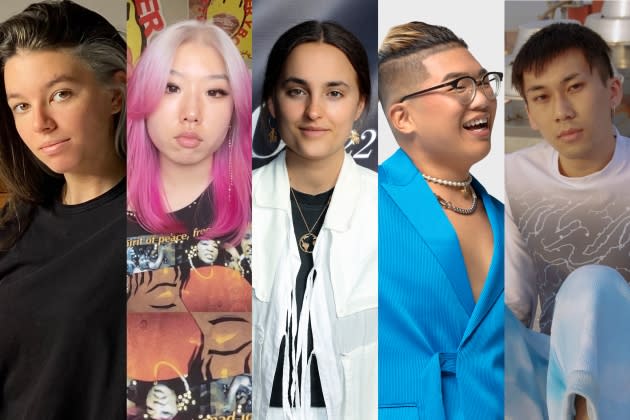
Students from the class of 2022 are, in many ways, a product of their larger environment. These young fashion designers completed more than half their education during the pandemic, while the world around them endured upheaval and long-overdue social shifts.
While business interests have since allayed some of the fashion industry’s urgency around sustainability, social equity and inclusion, these graduating fashion students are resolute in their beliefs. Themes of nature, sustainability, cultural bridge building and inclusion were paramount in collections from five recent graduates surveyed by WWD, who were highlighted by their respective schools for exemplary design work. Many of them incorporated high-execution knitting and upcycled textiles into their collections, imbuing designs with a sense of handcraft and longevity.
More from WWD
Here, students from five globally recognized, U.S.-based fashion design schools provide a window into their thesis collections and design ethos as they look toward a bright future:
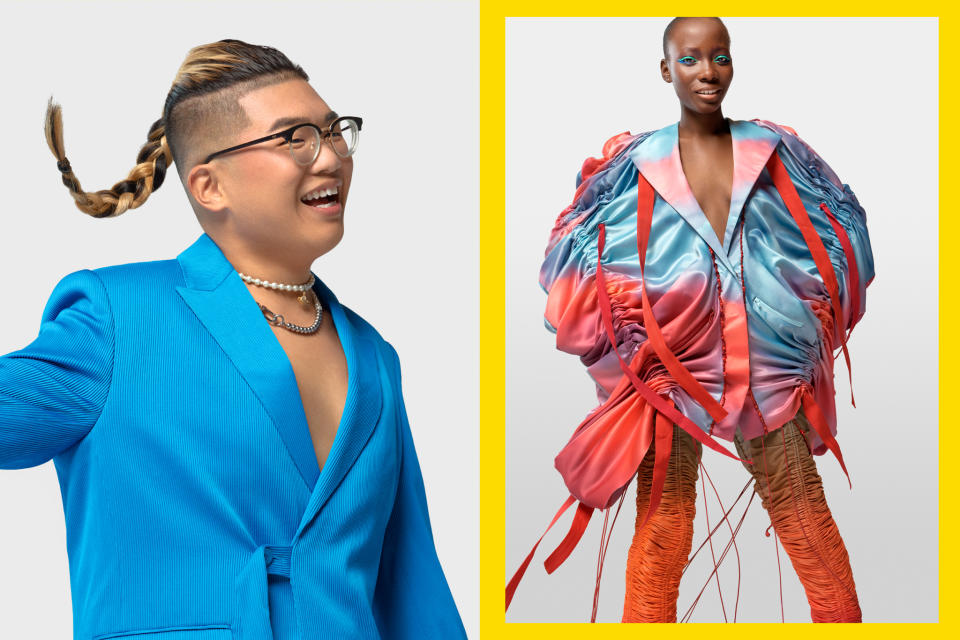
Courtesy
Savannah College of Art and Design
Name: Beckham Lin
Hometown: Changhua City, Taiwan
Age: 22
WWD: Talk a little bit about your thesis designs and concept.
Beckham Lin: This collection represents when a person leaves the comfort of home, like a bird leaving the nest to fly out into the world. Every journey people experience is moving toward a dream for themselves, just like the bird soaring to great new heights. The bird represents my journey of finding and building my own home and environment where I can be my true authentic self. Much inspiration comes from eastern and western cultural viewpoints of home and family dynamics. My collection explores the idea of [xiào or filial piety] and each look represents the different steps of growth and embracing freedom.
WWD: What is important to you as a young fashion designer? Where do you think the industry can improve?
B.L.: For me personally, authenticity and embracing my individuality is of upmost importance to have shine through in my art and collections. Fashion gives me a platform to communicate my feelings, desires, beliefs and connect with others. Sustainability and inclusivity are themes that are incredibly important to me and my generation of peers. It is inspiring that the broader fashion industry is making sustainability, body positivity, sexual identity and overall inclusivity a priority, and that there is also an openness to embrace new talents, especially a multicultural designer like myself.
WWD: Anything you’d like to say to designers who have inspired you along the way?
B.L.: Three designers have had a profound impact on me as an artist and designer, and allowed me to see fashion as a true art form. To Iris Van Herpen, thank you for creating such incredible and thought-provoking garments. To Alexander McQueen, thank you for your genius and sharing your art of storytelling through design. To Guo Pei, thank you for always embracing your culture and traditional Chinese influences in your creations.
WWD: Do you have a job lined up? If so, where?
B.L.: Next month, I’m excited to be moving to New York City. I’ve been overwhelmed with the amazing and positive feedback I’ve received on my final SCAD collection, and hope to dedicate my time developing my collection and making meaningful industry connections.

Courtesy
Fashion Institute of Technology
Name: Monica Palucci
Hometown: Pound Ridge, N.Y.
Age: 25
WWD: Talk a little bit about your thesis designs and concept.
Monica Palucci: Entitled “Close to Home,” my thesis work references memories on the nature preserve I grew up on. It is a reflection of my relationship to the natural world. My work aims to explore a reciprocity with nature — facilitating outdoor experiences while taking a critical look at outdoor culture. Multifunctionality and low waste practices were implemented to extend the use of garments. Single fiber materials, hand-sewn reusable hardware and biodegradable wax treatment were used to ensure circularity. My juxtaposition of found artifacts, traditional techniques, upcycled hiking gear and technical design is a nod to the disconnect between nature and how we sometimes engage with it.
WWD: What is important to you as a young person fashion designer? Where do you think the industry can improve?
M.P.: After my first year at FIT, I took some time to reflect on what it would look like to approach fashion in a way I can feel good about. I immersed myself in sustainability, ethics and size inclusivity studies — seeking opportunities and experiences that would help me answer this question.
At this point, it is widely understood that the industry has to improve on its sustainability practices, but that can be convoluted at times. A commitment to long-term solutions is crucial. I think starting with fashion education is one great way to start.
WWD: Do you have a job lined up? If so, where?
M.P.: I am currently interning for Danielle Elsener at Decode MFG and doing some freelance upcycling design on the side.
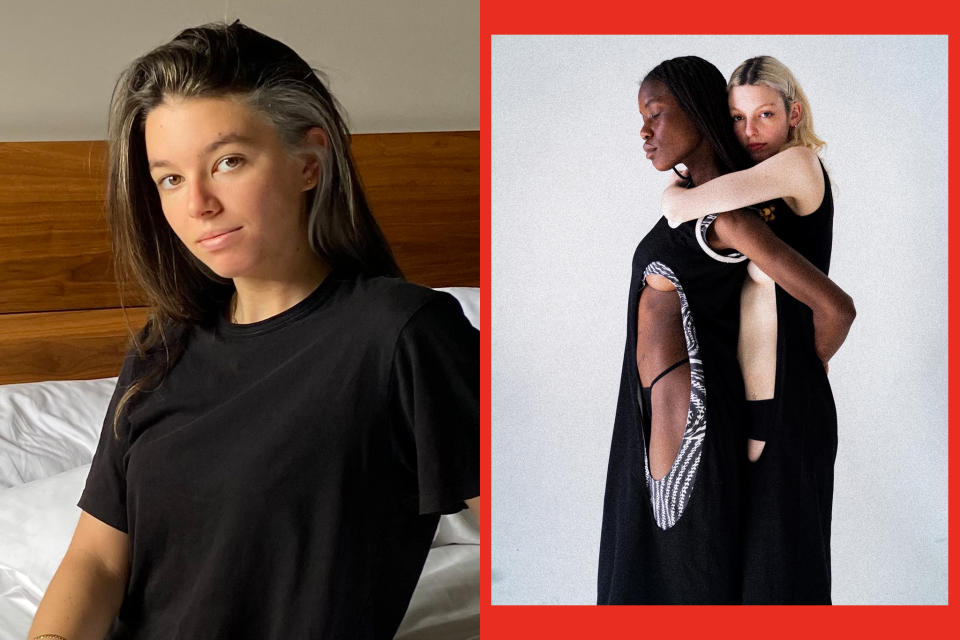
Courtesy
Parsons School of Design
Name: Briah Taubman
Hometown: Los Angeles
Age: 22
WWD: Talk a little bit about your thesis designs and concept.
Briah Taubman: My knitwear collection “Broken/Open” is inspired by a beautiful and suffocating relationship that ultimately ended. This collection was born of my affinity for yarn knits, and vibrant colors.
The “anxiety shirt” embodies this collection the most. The black and red, cutout/spiral top pays homage to the visceral anxiety I felt in deciding whether I should let go or cling to my relationship out of fear I wouldn’t find a love like that again. Just like my shirt, I was bursting at the seams.
WWD: What is important to you as a young fashion designer? Where do you think the industry can improve?
B.T.: It’s unfortunate to me that the industry has lost nuance as the collective continues to shift toward mass production, fast-fashion and the rise of digital clothing.
I fell in love with fashion because as an outlier, I finally found an art form in which I could express myself. I wish consumers of fashion appreciated the ateliers and the process of handmade clothing that takes months of meticulous design and craft. I wish design houses only released two seasons a year, thus giving the designer time to muse and garner inspiration for their collections without the pressures of impatient consumerism.
WWD: What is your dream job? Anything you’d like to say to designers who have inspired you along the way?
B.T.: My dream job is to have my own brand, Artemis. I want my brand to give a voice to women who feel shy or unable to express themselves with words, just as I struggled to as a kid. I want my clothes to highlight my consumers’ personalities.
My other dream jobs would be to work for designers like Glenn Martens, Kiko Kostadinov and Jonathon Anderson; these designers make me fall in love with fashion all over again with every collection.
WWD: Do you have a job lined up? If so, where?
B.T.: I am currently working as a freelance knitwear designer for a knitwear consulting company called Studium. Alongside this, I am a freelance assistant stylist for independent stylists and magazines, currently W and Mastermind magazine.
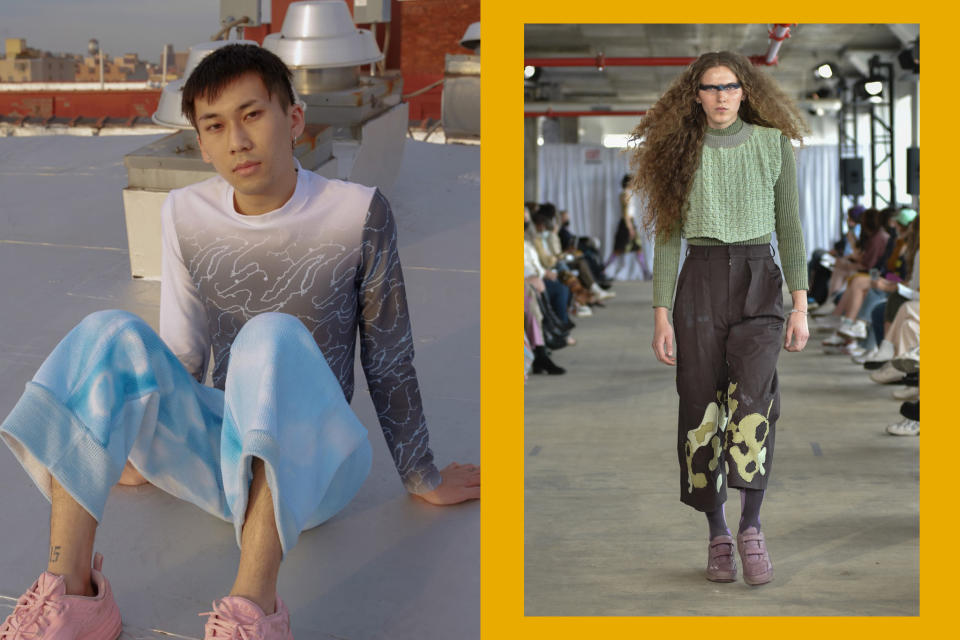
Courtesy
Pratt Institute
Name: Trung-Tin Pham
Hometown: San Diego
Age: 21
WWD: Talk a little bit about your thesis designs and concept:
Trung-Tin Pham: This collection, titled Synonym, is a fictional world I created stemming from fake IDs. [When non-white communities have] a handed down ID, there is a photo showing someone who looks similar, and due to microaggressions and racism, the fake is accepted. Growing up as an Asian American, there are many times where I have experienced the casual grouping of Asian boys as one archetype. Synonym is my satire response to it all, casting 12 similar-looking models all posing as “Trung-Tin.”
My designs incorporate elements that can be found in different places throughout the collection, creating a feeling of clones.
WWD: What is important to you as a young fashion designer? Where do you think the industry can improve?
T-T.P.: I think representation is very important to the industry. Growing up Vietnamese American, I never saw people like me in any forms of media but I never questioned it. Moving out of my town made me realize the importance of representation in all forms of art. The fashion industry needs to improve by humanizing people and work[ing] on diversity until it is reflected within all levels of the industry.
WWD: What is your dream job? Anything you’d like to say to designers who have inspired you along the way?
T-T.P.: My dream job is to be a knit programmer working with Stoll or Shima machines. During my undergraduate I fell in love with knitting after taking a Shima Seiki class. My collection heavily relied on some complex programmed knitting, which I am very proud of. I have always strived to incorporate technology into my craft.
WWD: Do you have a job lined up? If so, where?
T-T.P.: I do not have a solid job lined up, but I plan on relocating from NYC back to California to get closer to all the programming knit jobs on the West Coast.
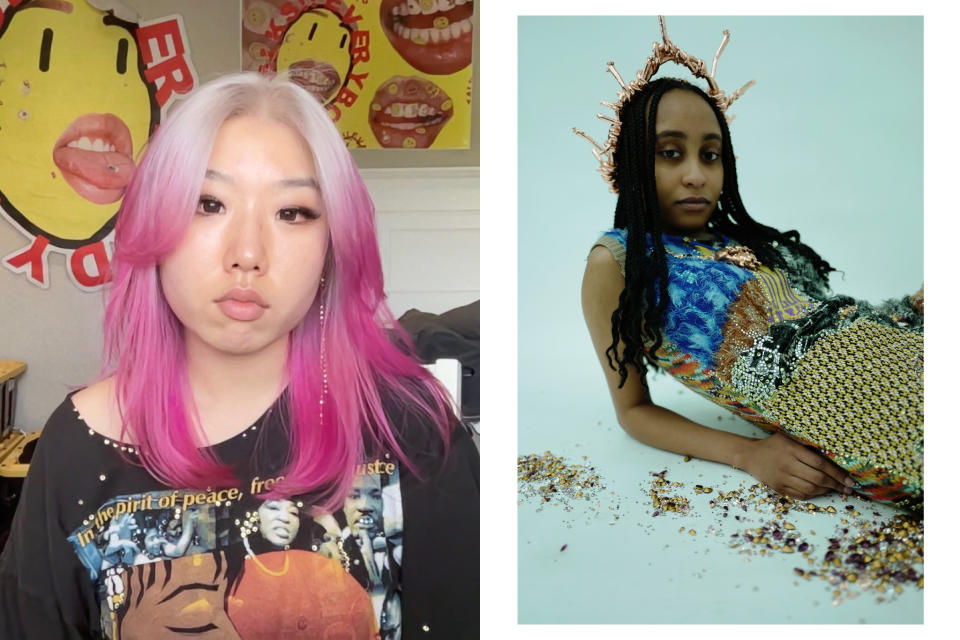
Courtesy
Rhode Island School of Design
Name: Jackie Oh
Hometown: Seattle
Age: 25
WWD: Talk a little bit about your thesis designs and concept.
Jackie Oh: The overall aesthetics took inspiration from music artists who adorn themselves in diamond-encrusted gold Jesus pieces, and oversize garments; as well as extravagant paintings of Christ, his followers and enemies from the past. Bordering on kitsch, camp and cathartic, I mixed casual, yet over-the-top pieces with a “more is more” mentality.
WWD: What is important to you as a young fashion designer? Where do you think the industry can improve?
J.O.: I never focused heavily on the garments alone — I originally majored in FAV [film, animation, video] before taking on apparel design as well. And even then, I spent most of my time in the makeshift jewelry studio I set up in-between the sewing machines.
WWD: Do you have a job lined up? If so, where?
J.O.: Actually, once September hits I’ll be back in the classroom as a post-Bacc student here in Seattle. Hopefully I can get all my science prerequisites done in the next couple years and then apply like crazy to dental school. In the meantime, I’m working on a second children’s book with my brother, as well as spending some time in a couple of jewelry studios around the area.
Best of WWD
Sign up for WWD's Newsletter. For the latest news, follow us on Twitter, Facebook, and Instagram.